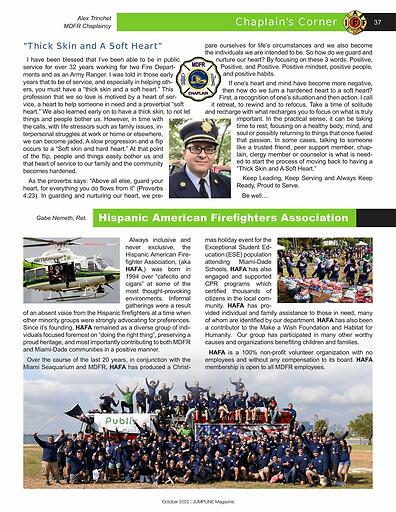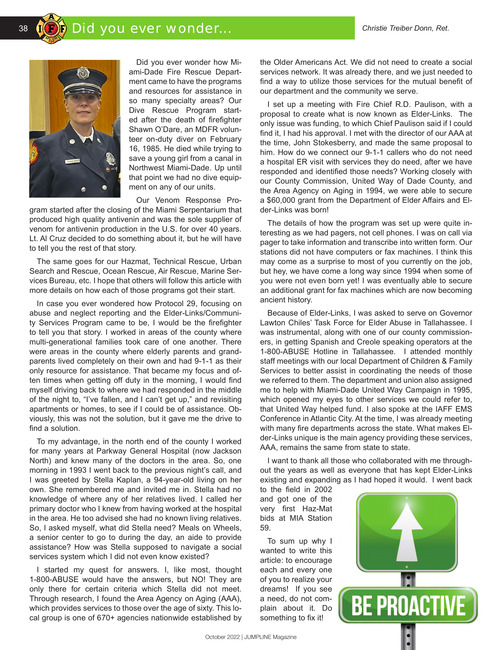Jumpline magazine OCT 2022-pages - Flipbook - Page 36

36
Original Jump Line
As the first Editor of the JumpLine,
it was great to see the return of Local 1403’s newsletter. The new edition was extremely well done, and I
congratulate President William McAllister, Editor Jack Swerdloff, and all
those that contributed to producing
it. I know very well how much time
and effort that goes into putting it all
together.
Mickey Donn
1403 President Emeritus
calling out those we felt responsible for not giving our department the personnel and resources we needed to do our
jobs. Whether it was a chief, politician, or county manager,
we let them know they were not doing their job for the community or our members when it came to safety and staffing.
Suffice it to say, they were not as enthused about this new
communication tool as our members were.
Before Local 1403 had a newsletter, the membership
mostly got their Local news through an occasional “update”
letter, attending a union meeting, or by word of mouth. Computers were in their infancy and there was no emails or text
messaging. Social media, like Facebook and Twitter, did not
exist. The members had no outlet to communicate the good,
the bad, or the ugly happening at their stations or battalions.
In 1980, President Emeritus Dominick Barbera had begun
his first term in office. Although I was not part of the board, I
assisted with various tasks such as selling T-shirts, contributing to various charitable and political events the Local participated in, attended commission meetings, etc. We did not
have an office back then, so everything operated out of the
trunks of our cars. Later that year or early 1981, he told me
that he had not been able to find anyone on the board that
would start a newsletter for the Local and asked if I would do
it. I agreed to do the newsletter, although I had never done
one before. I had always enjoyed writing so I thought I would
give it a shot.
The Jumpline also began to demonstrate all the positive
things our members were doing. We highlighted firefighters sponsoring and participating in charitable events. Big
fires and our memberships’ heroic deeds were published
with pictures to go with it. We got to see and read about our
athletes participating and winning events like the Firefighter
Olympics and shared funny stories that were enjoyed by all.
One of our members, Steve Crabb, had a talent for creating
cartoons that we attached to a particularly important article.
With this new ability to spread information, we could also
honor brothers. We could share who passed, whether on or
off the job, and celebrate them for all they contributed to the
community and our department.
Without computers and the modern use of emails, article
contributions usually came in handwritten. They then had
to be edited and typed. Next, they were taken to a printer
to be formatted in a special type setting for the printing machines utilized at that time. The articles would be returned
in columns that would fit three rows on letter-sized paper.
We then had to cut and lay out each article, glue into place,
arrange for headlines and continuation print and then once
again return to the printer for printing. The printer produced
a blueline that I had to then approve before the final publication. The first issue came out on February 1981, and we put
out 11 issues that year. For our efforts, we took second place
in the IAFF for best union publication.
It was an immediate hit with the membership! The Local
had a new ability to directly communicate news of fire service
current events. With a county as big as Dade, firefighters at
a north end station could read about what was happening at
a south end station or any of the other widely scattered stations, in an exceptionally large county. Many times, county
stations were presented with similar problems and the Local
could identify these issues, address them, and resolve them.
Through the Jumpline, communication of these resolutions
was also shared.
One of the biggest reasons this publication was popular
amongst the membership, was that we were not shy about
In the early days of the Jumpline, getting this publication
out was a lot of work, but I must have liked doing it, as I remained editor from 1981 until 1994. Guess it was what they
call a “labor of love!” When I began my first term as president, Stan Hills became the next editor.
Again, congratulations to the Local for bringing it back!
October 2022 | JUMPLINE Magazine













